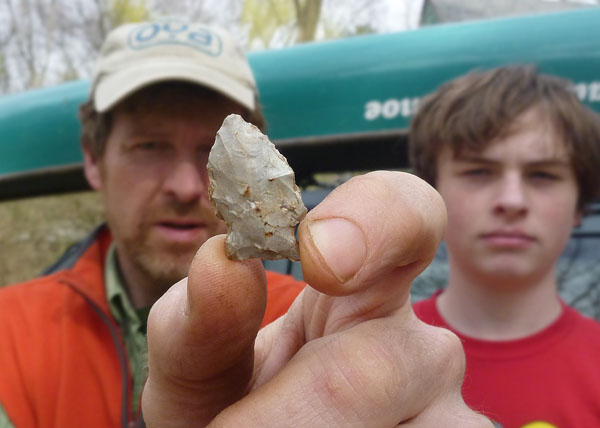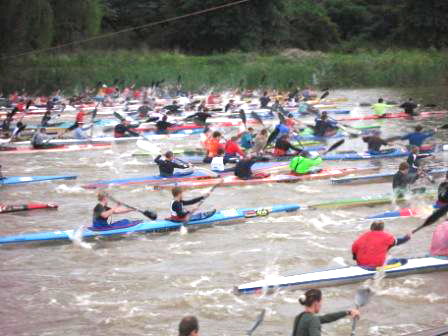Henry and I did our first big canoe day today. It weren’t too big, though — just right for him.
We did the 13-mile Quarter Hugh of the Hugh Heward Canoe Challenge — an annual paddle on a wild’n’scenic portion of the Grand River near Lansing, commemorating the day in 1790 when HH outran hostile locals as the first white guy to paddle across the peninsula. He paddled 55 miles to get outta town, according to his journal. So that distance is offered, and taken up by many hardcore types. There’s also a Half Hugh.
My impression from reading a bit o’ history is that the Indians were pleasant in this vicinity but misunderstandings and trespasses can/do occur.
The Quarter Hugh goes thru the length of the Portland State Game Area, the burial place of Chief Okemos. This area was highly favored, on a paradise status, as a summering ground for the local tribe. It’s a unique section of river that they probably liked even more than I do. Most of the Grand is straightish. But right where HH stirred up the hornets nest the river makes 3 3-mile oxbows in the space of a mile as the crow flies. The outside of each bend is a high horseshoe hardwood ridge, the inside is rich farming bottom-land. It is still dry and breezy (keeps down the skeeters), rich in fish and game, and easy to defend. There are hardly any houses on this stretch.
The Whole Hugh goes from south of Lansing, thru town, then heads to the coast. It’s a tasty “big day” mix of residential, parks, urban, industrial and wild sections.
So the river was REALLY high today. But not too high. I heard it crested at 12.5 feet high in Grand Rapids, whatever that means.
We whizzed along, making quick work of our 13 miles.
What I love about the HH is the variety of boats and boaters. About 50 total craft do one of the versions each year. 20 do the Full, 20 the Half and 5-10 do the Quarter. It’s interesting to me that the easiest and most scenic stretch draws the fewest paddlers. We see race boats, sea kayaks, homemade craft. This year there was a 4-person kevlar racing “war canoe” with laterally sliding center seats — you scootch to the opposite gunnel on the “hut” and don’t mess up or the boat will roll, as per some YouTube videos. There was a homemade ocean voyaging canoe-sailing boat. There were a couple “trans-continental” type boats with expedition signage painted on them. And I enjoyed seeing a somewhat older gent paddling a full-on racing sea-kayak with wingpaddle — he’s a racer.
The HH was first paddled by the legendary Verlen Kruger. He paddled more than anyone, ever — 100k miles. A dozen or so boats each year are of his design. His fans are often adventurers themselves so I suppose “going big” is the name of the game.
Offhand, it seemed to me that the half dozen college-age cruiser folks there were all really kitted up — head to toe tech-apparel, drysuits and accessories — sometimes perhaps $500-worth layered on each person. The racer and adventurer types mostly wore t-shirts. Of course, each sector had its common look. I personally just wish that more of the 50,000 or so local students would just Get Out There. The barrier to entry doesn’t have to be more than the shirt on your back. I also overheard the young folk discussing highly technical matters involving rock and ice climbing and where in the USA are their fave places. Yet I’m pretty sure this was their first time on their local no-cost wild river. As you may know, that’s another of my hopes: that young po’ folk would begin to explore their world at home. They were marveling at the high skill level of mountain people: well, sure, it’s where they live, for a few years, anyway. “Bloom where yer planted” is always a good one. It’s hard to appreciate, though, I know. It takes an EXTREME personality to break on thru to the other side of a drab-appearing county like ours. It takes a lot of TRAINING. You start small, work your way up, then go BIG. But you don’t have to go far away or go broke or make a huge enviro footprint impact.
When we reached the picnic in the park at the finish a dozen folks were already there, milling about. Also milling about at the waters-edge was a frisky mink! He didn’t seem to notice or care about the people and they hadn’t seen him. He didn’t even seem to mind us very much, just casually loping away. As soon as folks glanced toward us arriving some of them noticed him and got excited, then he was gone. Henry had never seen one.
We had another “first” earlier. I’d always wanted to stop at one of the bottom-land farms as I paddled through. I’d heard that you can find arrowheads in freshly plowed fields near where Indians lived. In the spring after a rain the dirt washes off the stones on the surface and presto! But the timing was never right the other times I’d been down the river. I’d glance over and see old corn still standing or see the green of new crops coming up. Today in one oxbow I saw dirt. I mentioned my theory to Henry and he groaned. Let’s not waste time, etc. But we pulled over anyway. We went for a stroll along the edge of the field. In a few minutes I found a delightful little bird Point arrowhead just laying there, neat as a whistle. YAY! My first ever such find.
…Actually, it makes me want to go back asap!
I already mentioned an amazing thing about this section of river. Well, you can paddle this 13-mile stretch then ride a bike back 4 miles to your put-in to do a self-shuttle. You can do a 1.5-hour paddle and 1-mile ride if you really want to compress things (and stick to pure bottomland oxbows).
I suppose I’m being a bit like a treasure-hunter telling where his great finds are made. Or a trout fisherman telling where they’re biting. Bad ideas. But what the heck.
It gets better.
A canoe racer pal is also a farmer. He noticed that my arrowhead wasn’t perfect. He said that was even better. Imperfect ones are found where the tools are made. Best ones are lost here and there while hunting. He thought I’d likely find more where I found this. Sweet!
The arrowhead was a hit at the finish.
I think it represents the good things that can happen when you mix things up. If you’re jammin’ along all day, stop now’n’then and smell the roses, look around. Don’t just go hard all the time, every time.
I’m itchin’ SO BAD to go on my annual Spring Fling Waterloo Ramble. Maybe next week! I’ll go down — 40 minutes away — and ride the 30 miles of little dirt roads in the Lower Peninsula’s biggest park. …Stop for a picnic. …Take a hike after the ride. …Then go for a canoe outing and do a little fishing. Yeah!


